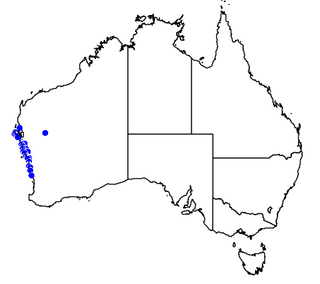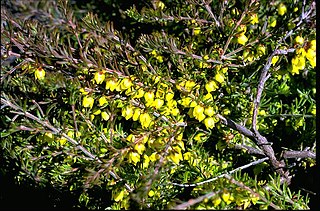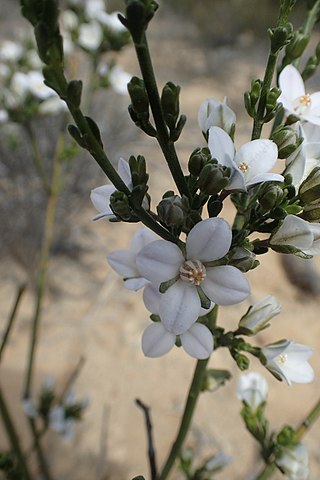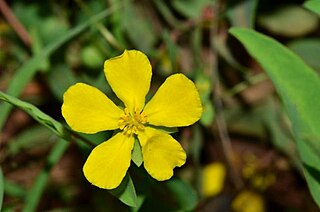
Eremophila dichroantha, also known as bale-hook eremophila, is a flowering plant in the figwort family, Scrophulariaceae and is endemic to the south-west of Western Australia. It is a shrub with many ascending branches making the plant appear broom-like. It has small, hooked leaves and small, though abundant, violet to lilac-coloured flowers.

Commersonia borealis is a species of flowering plant in the family Malvaceae and is endemic to the southwest of Western Australia. It is a low growing, spreading shrub with egg-shaped to oblong leaves, and white, yellow and cream-coloured flowers.

Eremophila caerulea, commonly known as spotted eremophila, is a flowering plant in the figwort family, Scrophulariaceae and is endemic to the south-west of Western Australia. It is a low, compact, spreading shrub with narrow, warty, cylindrical leaves and blue to purple flowers.

Eremophila platythamnos, commonly known as desert foxglove, is a flowering plant in the figwort family, Scrophulariaceae and is endemic to Australia. It is an erect shrub with short, broad leaves and purple, mauve, blue or pink flowers.
Verticordia stenopetala is a flowering plant in the myrtle family, Myrtaceae and is endemic to the south-west of Western Australia. It is a low shrub with small leaves and heads of pink to magenta-coloured flowers in late spring and early summer.
Balaustion grandibracteatum is a species of flowering plant in the family Myrtaceae and is endemic to inland Western Australia. It is a shrub with mostly narrowly oblong to elliptic leaves and white flowers with 14 to 27 stamens.
Balaustion grande is a species of flowering plant in the family Myrtaceae and is endemic to the south-west of Western Australia. It is a low-growing shrub with oblong or narrowly oblong leaves and usually white or pale pink flowers with 16 to 28 stamens fused in a ring.

Boronia purdieana is a plant in the citrus family, Rutaceae and is endemic to the south-west of Western Australia. It is a shrub with pinnate leaves and yellow, four-petalled flowers arranged singly in leaf axils.

Cyanothamnus fabianoides is a plant in the citrus family, Rutaceae and is endemic to the south-west of Western Australia. It is a compact shrub with many branches, simple, more or less cylindrical leaves and single white, pink or pale blue four-petalled flowers in the leaf axils.

Philotheca deserti is a species of flowering plant in the family Rutaceae and is endemic to inland Western Australia. It is an erect shrub with narrow spindle-shaped, glandular-warty leaves and white flowers arranged singly in leaf axils.

Philotheca tomentella is a species of flowering plant in the family Rutaceae and is endemic to the south-west of Western Australia. It is an undershrub with small club-shaped to cylindrical leaves and white flowers with a pale red central stripe, arranged singly or in groups of up to four on the ends of branchlets.

Androcalva luteiflora is a species of flowering plant in the family Malvaceae and is endemic to western Australia. It is an erect, sucker-forming shrub with egg-shaped leaves, the edges irregularly toothed, and clusters of 3 to 18 or more yellow flowers.
Goodenia nuda is a species of flowering plant in the family Goodeniaceae and is endemic to the Pilbara region of Western Australia. It is an erect to ascending herb with elliptic to lance-shaped leaves at the base of the plant, and racemes of yellow flowers.

Hibbertia silvestris is a species of flowering plant in the family Dilleniaceae and is endemic to the south-west of Western Australia. It is a prostrate to more or less erect or spreading shrub with hairy young branchlets, elliptic to egg-shaped leaves with the narrower end towards the base and yellow flowers with seven to ten stamens on one side of two softly-hairy carpels.
Lechenaultia juncea, commonly known as reed-like leschenaultia, is a species of flowering plant in the family Goodeniaceae and is endemic to the south-west of Western Australia. It is an erect, perennial herb or shrub with crowded, fleshy leaves, and pale blue flowers.

Lechenaultia stenosepala, commonly known as narrow-sepaled leschenaultia, is a species of flowering plant in the family Goodeniaceae and is endemic to the south-west of Western Australia. It is an open, more or less erect perennial herb or shrub with crowded, narrow leaves, and blue to pale blue or creamy-white flowers.
Lasiopetalum microcardium is a species of flowering plant in the family Malvaceae and is endemic to the south-west of Western Australia. It is a low, spreading or straggling shrub with hairy stems, heart-shaped leaves and blue, purple or white flowers.
Thomasia dielsii is a species of flowering plant in the family Malvaceae and is endemic to the south-west of Western Australia. It is a low, erect to spreading shrub with egg-shaped leaves with wavy edges, and purple, violet and blue flowers.
Thomasia multiflora is a species of flowering plant in the family Malvaceae and is endemic to the south-west of Western Australia. It is a low, spreading shrub with broadly egg-shaped leaves and mauve flowers.

Swainsona tenuis is a species of flowering plant in the family Fabaceae and is endemic to western continental Australia. It is a prostrate perennial herb with many stems, imparipinnate leaves with 5 to 9 egg-shaped leaflets with the narrower end towards the base, to linear or elliptic leaflets, and racemes of up to 7 purple flowers.












